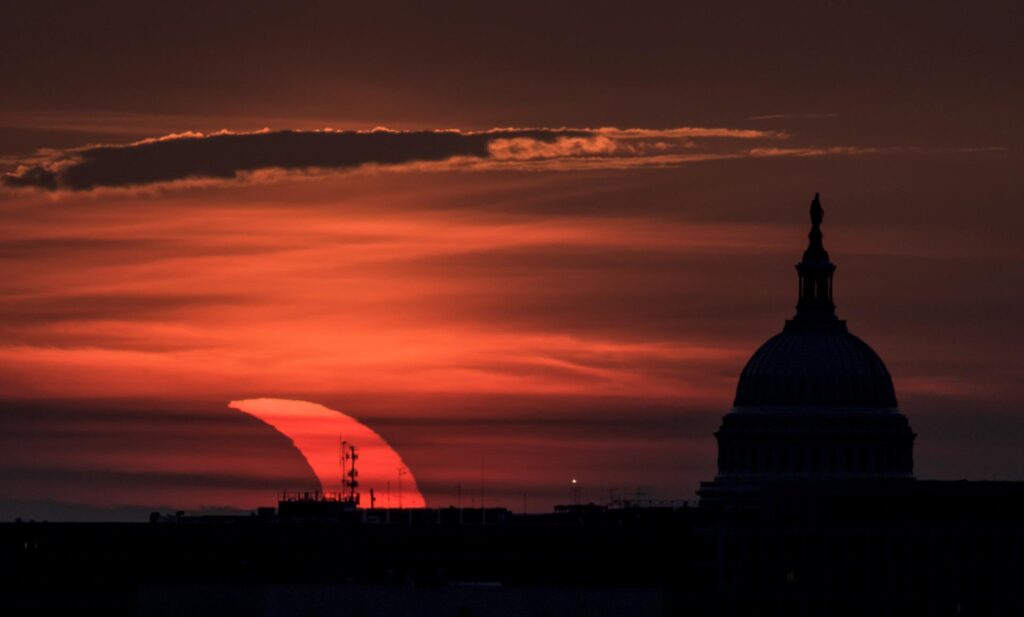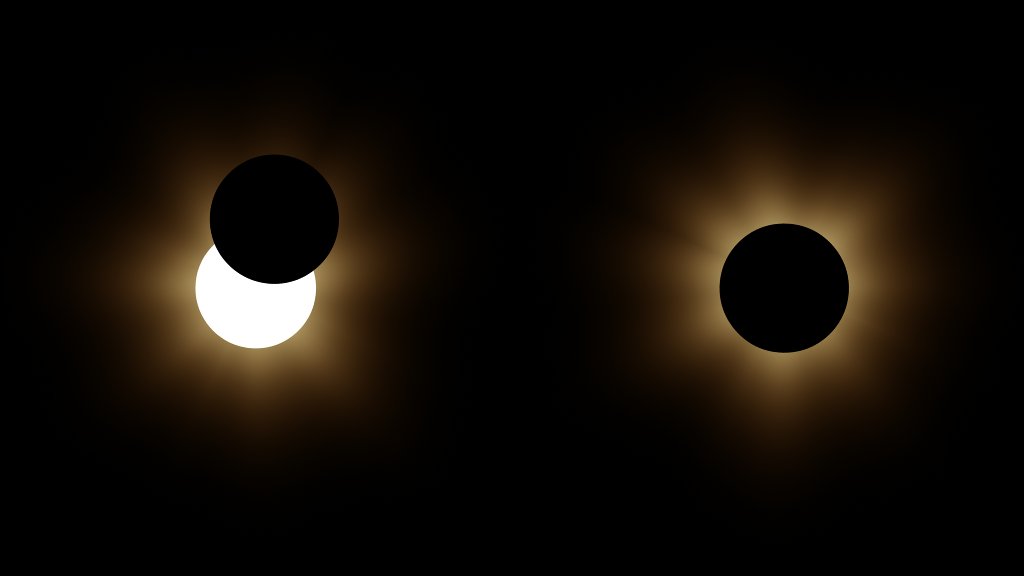The 2017 total solar eclipse, moments before complete totality above Oregon, United States. Featured Image Credits: Aubrey Gemignani, NASA, 2017-08-21.
A solar eclipse occurs when the Moon orbits in front of the Sun and covers some or all of the Sun’s face, creating a shadow called the ‘umbra’. If the Sun is completely obstructed by the Moon, then we call this type of eclipse a ‘total solar eclipse’.
When this umbra hits the Earth, it creates a ‘zone of totality’ – a region where the light and warmth of the Sun is blocked from reaching the face of the Earth. As the Moon orbits the Earth and the Earth orbits the Sun, the zone of the totality is stretched across a section of the Earth like a path. This ‘path’ can reach around 10000 miles long, but only 100 miles wide. Whilst standing within the zone of totality on Earth, one can view the mysterious outer atmosphere of the Sun known as the ‘solar corona‘ – as long as you use the appropriate safety equipment of course!

There are various other forms of solar eclipses, namely partial and annular eclipses.
A ‘partial solar eclipse’ is when the Sun is somewhat obstructed by the Moon, but the circular shape of the Moon is not entirely visible.
An ‘annular solar eclipse’ is when the Moon is fully visible over the Sun, but it is not close enough to the earth to completely block the whole face of the Sun; so that a ring of light is noticeable around the edge of the Moon.
You should never look directly at any solar eclipse without suitable protection! If you’re interested in learning more about eclipse safety and how this has changed through time, you can click here.
We can also get a special type of eclipse when the Earth lines up precisely between the Moon and the Sun – known as a ‘lunar eclipse’. This causes the Moon to take on a ghostly red hue, due to how the Earth’s atmosphere filters out different colours of light. Colours with longer wavelengths, like reds and oranges, can easily pass through the atmosphere. On the other hand, colours with smaller wavelengths, like blues and violets, get scattered back to space by the Earth’s atmosphere. Lunar eclipses are observable from many more locations on Earth than their solar counterparts, making them more commonly visible to people.
Zone of totality
So, what actually happens in the mysterious zone of totality? The first and most obvious effect is that the light levels are significantly reduced. This has the effect of making the day feel more like dusk or dawn.
Temperatures also decrease, due to the reduction of solar radiation, with the amount dependent of time, year, and location. For example, during the eclipse of 9th December 1834, temperatures were recorded to have dropped by roughly 15°C during totality. These temperature changes are comparable to those that occur when the sun rises and sets – except they happen much more rapidly.

A partial solar eclipse, visible here as the top half of a crescent-shape. Credits: Bill Ingalls, NASA
More than a spectacle?

So why do we care about eclipses? Do they serve any noteworthy scientific purpose? The answer is a resounding yes; scientists have studied a variety of natural phenomena through eclipses. For example, there are records of eclipses which date back thousands of years which have been used alongside other ancient records to date certain significant historical events.
More recently, before the advent of more modern technology like the coronagraph, eclipses granted 19th and early 20th century scientists a chance to study the Sun’s corona. They have also allowed scientists to achieve incredible feats such as the discovery of helium, or even verifying predictions made by the theory of general relativity.
Transit of Venus
The transit of Venus is an important astronomical event which relates to the history of solar eclipses. It occurs when the silhouette of Venus against the Sun is visible from the Earth. These events are much rarer than a solar eclipse. The last time a transit occurred was in 2012, and there will not be another until 2117!
Today these events do not provide scientists with much opportunity for discovery. However, in the 18th and 19th century, this event was crucial in calculating the distance of between the Earth and the Sun, to aid in estimating the size of the universe.
This was an extraordinarily difficult calculation to perform, in part due to something called the ‘black drop’ effect – where the edge of Venus seemed to appear to almost ‘smudge’ as it crossed passed the Sun. The scientific community used solar eclipses as practice for transit of Venus.

Glossary
| Term | Definition |
|---|---|
| Annular solar eclipse | A solar eclipse where the Moon doesn’t fully block out the Sun because the Moon appears smaller compared to the Sun. This is due to the Moon being near or at its furthest point away from Earth. |
| Lunar eclipse | Where the Earth lines up between the Sun and Moon, such that it blocks the Sun’s light from reaching the Moon. |
| Partial solar eclipse | A solar eclipse where the Moon doesn’t fully block out the Sun, due to the Moon not fully lining up with the Sun. |
| Path/zone of totality | The path or region where the Moon’s shadow is cast over the Earth’s surface, due to a solar eclipse. |
| Solar eclipse | Where the Moon passes between the Earth and Sun and ends up blocking out some or all the Sun from view on Earth. |
| Total solar eclipse | A solar eclipse where the Moon completely blocks out the Sun’s light from view, from the Moon fully lining up with the Sun. |
| Transit of Venus | Where the planet of Venus passes in front of the Sun, such that it is visible from Earth as a black dot on the Sun’s surface. |
| Umbra | The dark centre part of the shadow cast by the Moon during a solar eclipse. |
| Wavelength | The length of a single wave, measured between two wave peaks. |
Further reading
All About Eclipses (2022) NASA STEREO (Solar TErrestrial RElations Observatory) Learning Center, (Accessed: 29 June 2023)
Cofield, C. (2017) BRRR! how much can temperatures drop during a total solar eclipse?, Space.com, (Accessed: 29 June 2023).
Fox, K.C. (2015) Strong Evidence For Coronal Heating Theory Presented at 2015 TESS Meeting, NASA. Edited by H. Zell, (Accessed: 29 June 2023).
NASA (no date) Moon in Motion, NASA Science: Earth’s Moon, (Accessed: 29 June 2023)
National Eclipse (no date) Gettysburg Republican Banner – December 9, 1834, National Eclipse, (Accessed: 29 June 2023).
Royal Astronomical Society (RAS) (no date) Transits of Venus, The Royal Astronomical Society, (Accessed: 29 June 2023).
WeatherSTEM (2017) Solar Eclipse and Temperature, WeatherSTEM, (Accessed: 15 June 2023).
Zirker, J.B. , Houtgast, J. , Stephenson, F.R , et al. (2023) Lunar research, Encyclopædia Britannica, (Accessed: 29 June 2023).